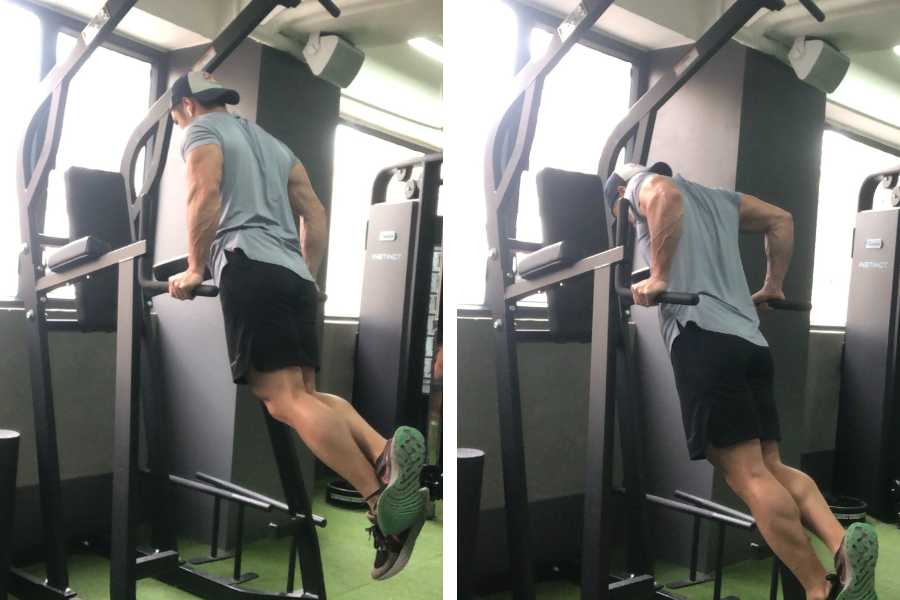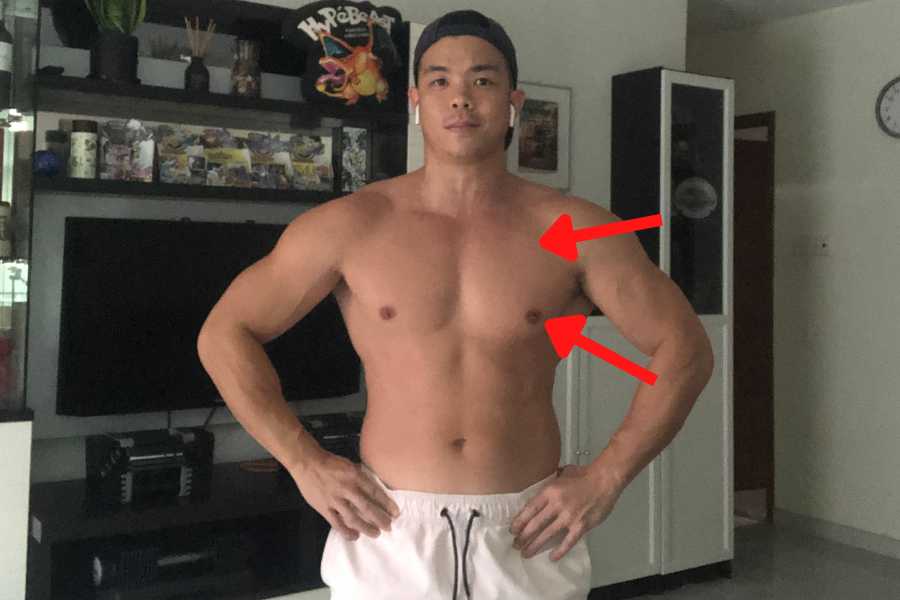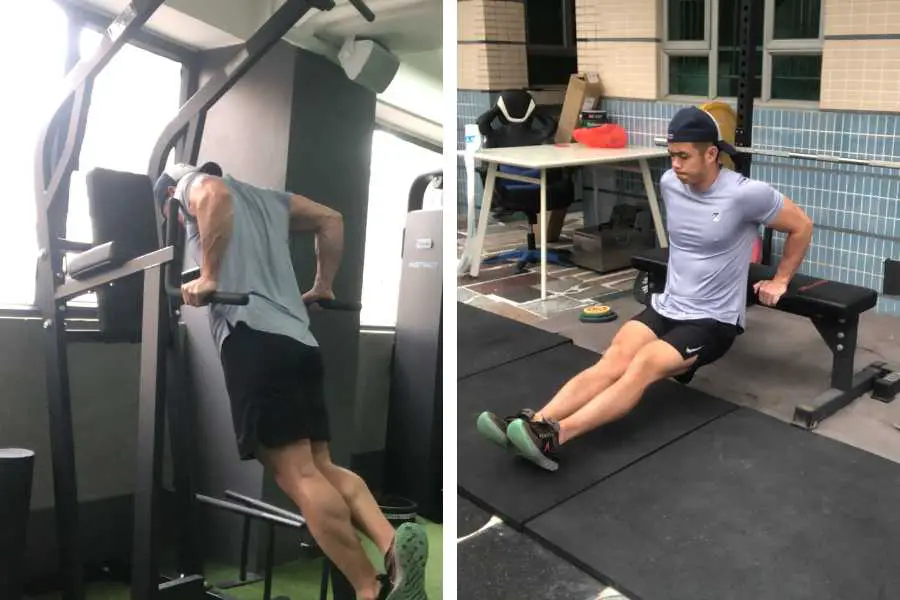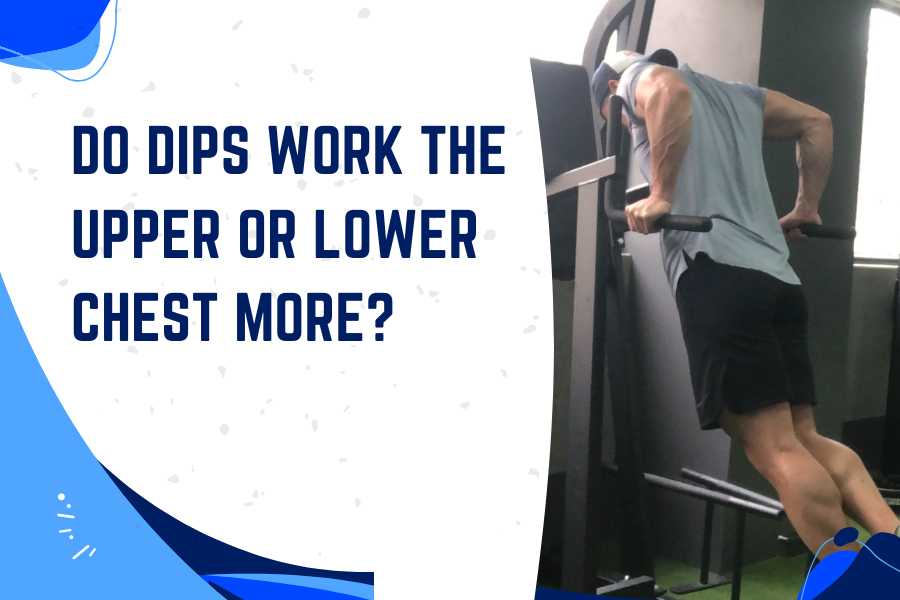To train your chest effectively, you need to be targeting the right areas for maximum activation. This post explains if dips work the upper or lower chest, which pec region sees the most activation, and if it’s even an effective exercise.
Chest dips predominantly work the lower chest when performed with the correct form. However, the mid and upper chest also are also activated. The degree of tension placed on the upper, mid, and lower chest depends on the torso angle in relation to the floor.
Whether you’re doing dips to build that pec cleavage, tone, or get a stronger chest, it’s essential to know how the dip targets your muscles.

Key Points
- Chest dips are different from bench dips.
- Chest dips are an effective way to target the entire chest (upper, mid, and lower) with emphasis on the lower pectorals.
- However, it can be a difficult exercise for newbies to do with the correct form.
- Most beginners will find the bench press to be more effective and easier to perform.
Parts Of The Chest Worked By Dips
Chest dips work the entire chest as well as the shoulders and triceps. Pectoral regions worked by the dip include the upper, mid, and lower pectorals. The degree to which the different pectoral regions are activated depends on the variation and angle of the torso when executing the dip.

Most people find the chest one of the most difficult muscles to grow.
Additionally, the bench press is the exercise that comes to mind for most people when asked about the most effective way to build a strong chest.
However, as this 2015 study shows, the chest dip is another excellent way to activate the entire pectoralis major (the largest muscle spanning the whole chest) when it is performed with the correct angle.
For optimal pectoralis major activation, you should dip with a wide grip and lean forward. This focuses tension away from the triceps and onto the pectorals.
Do Dips Work The Upper Or Lower Chest More?

A 2010 Study by Bret Contreras sought to answer the question; “do dips work the upper or lower chest more?”.
Here, EMG electrodes were attached to the different pectoral regions of the study participants. This allowed the upper, mid, and lower chest muscle (and triceps) activity to be measured as the participants performed the dip.
Here are the results:
| Exercise | Upper-Pec EMG Activation | Mid-Pec EMG Activation | Lower-Pec EMG Activation | Tricep EMG Activation |
|---|---|---|---|---|
| Weighted Dip | 232mv | 332mv | 418mv | 217mv |
You can see that the chest dip activates the entire pectoral muscle, albeit to different extents.
The lower chest was activated almost twice as much as the upper chest.
So despite the dip working the entire chest, the evidence suggests that this exercise works the lower chest more than the upper chest (when performed with the traditional slight-forward lean).
In order to gain maximum pectoral activation, it’s also important to use the right weight.
Is The Dip An Effective Chest-Building Exercise?
In order to determine the effectiveness of the dip, we can compare it to the bench press which is widely regarded to be one of the exercises for chest growth.
Both are compound exercises that work the chest, shoulders, and triceps. Additionally, both require a tremendous amount of upper body pushing strength to lift heavy.
Below are pectoral muscle activation results from Bret Contreras’ study comparing the dip vs bench press:
| Exercise | Upper-Pec EMG Activation | Mid-Pec EMG Activation | Lower-Pec EMG Activation | Tricep EMG Activation |
|---|---|---|---|---|
| Weighted dip | 232mv | 332mv | 418mv | 217mv |
| Incline bench press | 222mv | 374mv | 249mv | 84mv |
| Flat bench press | 230mv | 408mv | 347mv | 109mv |
You can see the dip works the lower chest more effectively than the bench press. In comparison, the dip works the mid-chest less effectively than the bench press.
All in all, I can say that the dip and bench press can offer comparable results when they are performed with the correct form and intensity (you can check out my other post for dips weight standards). In fact, the chest dip is great for building the lower pecs and developing the defined chest cleavage that most people look for.
However, it’s much harder for a beginner to execute the dip with good form compared to the bench press (despite both exercises giving comparable results).
Thus, I would always recommend a newbie begin bench pressing before doing chest dips.
5 Reasons To Avoid Doing The Chest Dip
Beginners may want to avoid doing the chest dip and choose the bench press instead for the following reasons:
- Excessive shoulder stress. Performing the dip with your elbows flared outwards puts your shoulder into a state of internal rotation. This is not only uncomfortable but can also reduce the amount of weight you can lift and even lead to injury.
- Strong core required for maximum benefits. You need a strong set of abs to keep your torso in the optimal forward-lean angle. Most beginners cannot do this efficiently when doing the dip..
- Not a beginner-friendly movement. The above two points make the dip a challenging exercise for most novices.
- Less weight can be lifted vs bench press. The above point means most novices can bench more weight (and therefore build more muscle) than they can lift on a dip.
- Requires dip bars. Most gyms have plenty of weight benches but only 1 or 2 dip bars. Likewise, you’ll need to invest in dip bars to do chest dips at home. The bench press is simply a more convenient exercise to perform.
All in all, it’s much easier to train the chest using the bench press and other free-weight pec exercises. You can check out my other post for a list of dumbbell-only pec exercises.
Best Ways To Target The Upper And Lower Chest
Here’s a list of alternative exercises to target the upper and lower chest without dips:
| Upper Chest Exercises | Upper Chest Exercises |
|---|---|
| Incline bench press | Flat bench press |
| Incline dumbbell fly | Decline bench press |
| Decline push up | Decline dumbbell fly |
| Upward cable cross-over | Downward cable cross-over |
You may also be interested in my other post for a full guide to building a big chest with dumbbells.
Difference Between Chest And Bench Dip
Chest and bench dips are both compound bodyweight exercises that target the pectorals and triceps. However, the angle and position of the upper arms lead to slight differences in muscle activation. The bench dip is tricep dominant whereas the chest dip is pectoral-dominant.

The main differences between the two types of dip in detail:
| Chest Dip | Bench Dip |
|---|---|
| Executed on parallel dip bars. | Executed on a flat surface such as a bench. |
| Chest is the primary mover. | Triceps are the primary mover. |
| Triceps are the secondary stabilizer. | Chest is the secondary stabilizer. |
| Usually performed with a wider grip. | Usually performed with a narrower grip. |
| Torso leans forward. | Torso leans backward. |
Understanding the differences between a chest dip and a bench dip is important because they emphasize different muscle groups.
For clarification purposes- this post analyses upper vs lower chest muscle activation in the chest dip (not the bench dip).
Conclusion
Dips have been shown to work the lower chest more than the upper chest. With that being said, it will still activate the entire pectoral muscle. It’s just that the emphasis is on the lower pecs.
It’s an effective exercise to build a bigger and stronger upper body. But beginners should generally focus on the bench press instead since it allows for more weight to be lifted more easily.
You may also be interested in the downloadable Kalibre Blueprint PDF which details exactly how I gained 40lbs of lean muscle (it’s 100% free!). It details the exact exercises and nutrition (with printables) I used to go from skinny to ripped!


